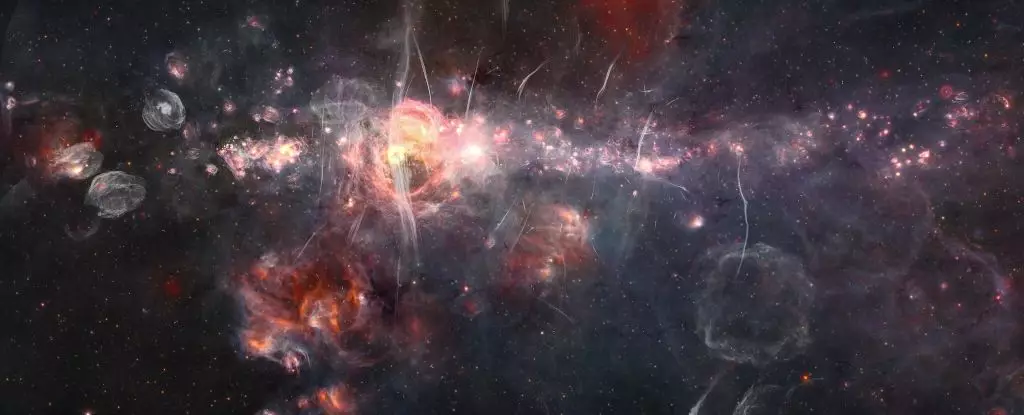While the supermassive black hole at the center of the Milky Way, known as Sagittarius A*, may appear stable at first glance, the surrounding cosmic environment is anything but tranquil. New research sheds light on extraordinary phenomena occurring in this dynamic region, particularly through the detection of high-energy gamma rays from a source, HAWC J1746-2856. These findings highlight the Milky Way as a rich site for extreme astrophysical processes, including the remarkable cosmic accelerator known as a PeVatron.
Researchers at the High-Altitude Water Cherenkov (HAWC) observatory, located in the mountains of Mexico, have recorded an unprecedented number of gamma-ray events emanating from the galactic center. Over the course of seven years, they observed a staggering 98 instances of gamma rays, each exceeding 100 teraelectronvolts (TeV). These revelations suggest that the center of our galaxy is not merely an area of interest but a veritable cosmic laboratory, potentially hosting some of the most extreme physical processes in the universe—specifically, those associated with PeVatrons.
What Are PeVatrons?
PeVatrons are natural particle accelerators capable of accelerating cosmic rays to extraordinary energies. Cosmic rays are high-energy particles, predominantly protons and atomic nuclei, which traverse the universe at velocities approaching the speed of light. The environments where these PeVatrons form include supernova remnants, newly formed stars, and the intense magnetic fields surrounding supermassive black holes. When these particles are accelerated, they can reach energies as high as one trillion electronvolts, but pinpointing the locations of these formidable accelerators can prove challenging.
Pat Harding, a physicist at Los Alamos National Laboratory, has indicated that such high-energy phenomena are relatively rare in the Milky Way, often leading scientists to expect these processes outside of our galaxy. Indeed, events like the merger of black holes are typically seen in distant cosmic locales rather than in close proximity to Earth.
Gamma Ray Interactions and Detection Techniques
The intricate dynamics of high-energy cosmic rays often result in their abrupt deceleration due to interactions with space matter, such as magnetic fields or cosmic dust. This deceleration releases vast amounts of energy, transforming the initial cosmic ray into gamma radiation. However, the intensity of gamma radiation makes direct detection from the Earth’s surface nearly impossible. Instead, as these gamma rays penetrate the atmosphere, they interact with atmospheric molecules, producing a shower of secondary particles that can be detected.
Ground-based observatories, such as HAWC, utilize this principle by employing Cherenkov detectors that analyze the resultant particle showers. This technology enables physicists to backtrack and reconstruct the original gamma rays, determining their source locations with impressive accuracy.
Under the guidance of physicist Sohyoun Yu Cárcaron from the University of Maryland, HAWC’s detailed examination of its data has led to groundbreaking discoveries regarding potential PeVatron activity. The detected gamma-ray emissions from HAWC J1746-2856 are recognized as some of the most powerful recorded from the galactic center, yet the identity of this source remains a tantalizing mystery. Notably, researchers have found no matching supernova remnants in the vicinity of this emission source, creating further intrigue.
Two potential phenomena have emerged as possible contributors to this high-energy emission: Sagittarius A*, the supermassive black hole, and HESS J1746-285, an unidentified gamma-ray emitter located near a feature called the Radio Arc. Despite the lack of clarity surrounding HAWC J1746-2856’s identity, these findings affirm the presence of a PeVatron in the galactic center.
The implications of this research extend beyond just identifying the source of high-energy gamma rays. The results hint at a higher-than-average density of cosmic rays in the galactic center, suggesting freshly accelerated protons are indeed present in this region. This hints at an intriguing dynamic equilibrium, whereby the galactic center could serve as a significant reservoir for cosmic rays that might ultimately influence the broader cosmic landscape.
As researchers continue to probe these mysteries, they look forward to advancements in detection technology, particularly with the next generation of Cherenkov detectors. Such innovations hold promise for unraveling the enigmatic nature of HAWC J1746-2856 and its connections to the dynamic processes governing our galaxy.
The discoveries surrounding HAWC J1746-2856 illuminate the Milky Way’s vibrant and turbulent core, revealing the extraordinary capabilities of cosmic accelerators. As we delve deeper into the complexities of our galaxy, these revelations not only enhance our understanding of cosmic phenomena but also encourage further exploration of the universe’s more profound mysteries. The ongoing investigation into these high-energy sources may eventually piece together our galaxy’s convoluted narrative—a tale richly layered with cosmic history and dynamic interaction.

